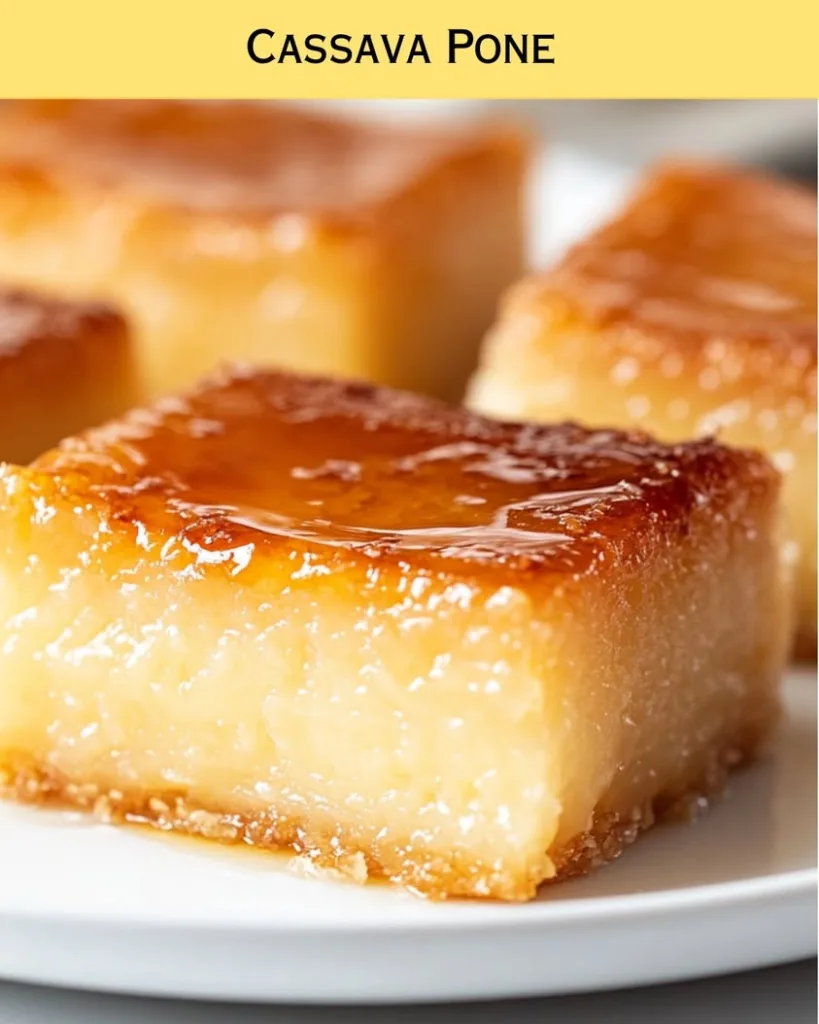Cassava Pone: A Delicious Caribbean Delight
Cassava pone is a traditional Caribbean dish that captivates with its unique flavor, vibrant appearance, and rich history. This delectable dessert features cassava, a starchy tuber that serves as its base, combined with spices, coconut, and other ingredients to create a mouthwatering treat often enjoyed during holidays and special occasions. The aromas that waft from the kitchen as it bakes are enough to make anyone’s mouth water.
With its pleasantly sweet flavor and delightful chewiness, cassava pone is not just food; it’s a connection to cultural roots and family gatherings. The dish can evoke nostalgia, reminding us of fond memories or celebrations with loved ones. The texture of cassava pone is wonderfully moist, with a hint of crispiness on the outside that perfectly complements the soft interior.
Quick Recipe Highlights
- Flavor Profile: Sweet and nutty from the cassava and coconut, with hints of cinnamon and nutmeg enhancing the overall taste.
- Texture: A wonderful balance of moist and chewy, with a slightly firm crust that provides satisfying contrast.
- Aroma: Inviting scents of cinnamon and fresh coconut fill the air as it bakes, creating an irresistible allure.
- Visual Appeal: Golden brown with a slightly darkened crust, cassava pone is visually appealing, drawing attention on any dessert table.
- Skill Level Needed: Medium; while the steps are straightforward, attention to detail is necessary for the perfect bake.
- Special Equipment: A mixing bowl, a grater for the cassava, and a baking dish are essential for making this recipe.
Recipe Overview
- Difficulty Level: This cassava pone requires a moderate skill level due to grating the cassava and achieving the correct blend of ingredients.
- Category: This dish falls under desserts and can also be classed as a snack due to its sweet yet hearty attributes.
- Cuisine: Hailing from Caribbean culinary traditions, cassava pone takes cues from African influence, particularly in its use of cassava flour.
- Cost: Ingredients are generally inexpensive, with cassava being widely available, making this a budget-friendly dessert option.
- Season: Best enjoyed during tropical weather or festive seasons, where its warm flavors are perfect for gatherings.
- Occasion: Ideal for family reunions, holiday feasts, or casual get-togethers with friends.
Why You’ll Love This Recipe
Cassava pone’s enchanting taste and texture are bound to leave a lasting impression. The nutty, slightly sweet profile combined with aromatic spices transforms this simple dessert into an indulgent experience. Each slice reveals the perfect balance of moistness and bite, creating a dish that pleases even the most discerning palates.
Convenience is another reason to adore cassava pone. With minimal preparation and straightforward cooking methods, you’ll find it is easy to whip up this delightful treat anytime you crave something sweet. Plus, it can be made in advance, allowing flavors to meld overnight for even greater satisfaction when served.
Nutritionally, cassava is a gluten-free alternative packed with carbohydrates, providing a great energy boost. Coupling it with coconut adds healthy fats, making this dessert not just delicious but also beneficial in moderation. Its balance of nutrients makes it a popular choice in many households.
Socially, cassava pone often plays a pivotal role in gatherings. It acts as a focal point at dessert tables, inviting guests to share stories and savor delightful moments together. Creating and enjoying this dish can elevate any gathering, leaving everyone reminiscing about family traditions.
Cost-effectiveness is yet another advantage of cassava pone. With affordable ingredients easily accessible, you can enjoy this culinary gem without stretching your budget. It’s an economical dessert option perfect for feeding larger groups without compromising on taste or quality.
Historical Background and Cultural Significance
Cassava pone’s origin story is deeply rooted in Caribbean culture, tracing back to indigenous communities who utilized cassava for sustenance. Adaptations over the years have woven together traditions from African, Arawak, and Spanish influences, resulting in the varied flavors we celebrate today.
Culturally, cassava pone holds a special place in Caribbean festivals and family gatherings. Its association with communal meals underscores its importance within social structures, bringing people together to share food and experiences that strengthen bonds and traditions.
As the recipe evolved, regional variations emerged, showcasing unique ingredients and methods. For instance, some cultures incorporate spices such as allspice or include dried fruits for added sweetness, demonstrating adaptability and creativity in cooking practices across different islands.
The dish continues to thrive in homes and restaurants, bridging generational gaps. Each family may have their interpretation of cassava pone, making it a beloved symbol of heritage and continuity in Caribbean cuisine.
Ingredient Deep Dive
– Cassava, the star ingredient, has a significant role in Caribbean diets, providing a gluten-free source of carbohydrates. Nutritionally, it’s rich in energy and fiber, ideal for maintaining gut health. When selecting cassava, opt for firm, unblemished tubers, and store them in a cool, dry place. If unavailable, yam or plantain can serve as substitutes in some recipes.
– Coconut complements cassava perfectly in terms of flavor and texture. It boasts healthy fats that can enhance overall health, especially heart health. When using coconut, fresh is best; however, dried or canned varieties can be handy. Ensure to check expiration dates and store them in airtight containers to maintain freshness.
Common Mistakes to Avoid
- Not grating the cassava fine enough will result in a gritty texture.
- Omitting essential spices like cinnamon can lead to blandness in flavor.
- Overbaking may cause the outer crust to become too hard while the inside remains undercooked.
- Not tasting the mixture before baking can lead to incorrect sweetness levels, affecting the final product.
- Measuring ingredients inaccurately can throw off the balance, leading to a failed recipe.
- Using old coconut can spoil the dish, so always check freshness before use.
- Neglecting to grease the baking pan properly can result in sticking, ruining the presentation.
- Skipping the cooling time post-bake can cause the texture to collapse.
- Not allowing flavors to meld overnight can diminish the depth of taste.
- Trying to rush the cooking time may lead to insufficiently set cassava pone.
Essential Techniques
– Grating cassava is essential to achieve the right consistency for your pone. Use a box grater or food processor for efficiency. Ensure that the cassava is fresh and firm; this will significantly impact the texture of your final dish.
– Baking at the right temperature is crucial for the perfect cassava pone. A moderate temperature ensures even cooking without burning the edges. Keep an eye on it as it approaches finishing time; the top should be golden brown.
Pro Tips for Perfect Cassava Pone
– Always taste the mixture before baking to adjust sweetness and flavor profiles as needed.
– If using frozen cassava, let it thaw completely and drain excess water for optimal results.
– For added richness, use coconut cream instead of milk for a creamier texture and deeper flavor.
– Cover the pone with aluminum foil for part of the baking to prevent excessive browning while still allowing it to set.
– Let cassava pone rest before slicing; this helps improve the texture and makes serving easier.
– Experiment with different spices and nuts to find your ideal blend; walnuts and pecans add a delightful crunch.
– For a dessert twist, serve with vanilla ice cream or whipped cream for added decadence.
– Keep leftovers in an airtight container in the fridge, and enjoy within a few days for the best texture and taste.
Variations and Adaptations
– Regional variations of cassava pone incorporate local flavors and adaptations, such as the addition of rum or variations in the type of sweeteners used, depending on availability.
– Seasonal adaptations may include adding fresh fruits or spices relevant to the time of year, like pumpkin during fall or tropical fruits in summer.
– Dietary modifications can be made by substituting refined sugar with natural sweeteners like honey or agave nectar for a healthier version.
– Flavor variations can introduce citrus zest or vanilla extract for a more aromatic experience, greatly enhancing the taste profile.
– For those seeking different textures, incorporating crushed almonds or walnuts can add a pleasant crunch to the soft consistency.
– Presenting cassava pone as individual servings rather than in a whole piece can make it more appealing for gatherings and parties, enhancing individual enjoyment.
Serving and Presentation Guide
– Plating cassava pone can be elevated by using a simple white dish that contrasts with the golden color, allowing it to shine as the star of the dessert table.
– Garnishing with toasted coconut flakes or a sprig of mint can enhance visual appeal and add freshness to each cut.
– Traditionally, cassava pone is best enjoyed warm, but it can also be served cold; reheating gently can restore its delightful texture.
– Accompanying this dish with tropical fruits like mango or pineapple offers a refreshing contrast that complements the flavors beautifully.
– Portion control is key when serving; aim for moderate slices to allow guests the chance to try multiple desserts.
Wine and Beverage Pairing
– Pair cassava pone with a fruity white wine such as a Riesling or a light-bodied Pinot Grigio to complement the dessert’s coconut and spice notes.
– If looking for non-alcoholic alternatives, a refreshing lemonade or coconut water can provide a lovely balance to its sweetness.
– For coffee lovers, a light roast coffee or a nutty espresso perfectly accompanies the dessert while enhancing its textures.
– Serve beverages chilled to provide a contrast against the warmth of the freshly baked pone, enhancing the overall dining experience.
Storage and Shelf Life
– Store leftover cassava pone in an airtight container at room temperature for up to three days, or refrigerate for a week.
– In the fridge, ensure it is completely cooled before covering to maintain the top crust’s texture.
– Always check for signs of spoilage before consuming; a sour smell or change in texture indicates it’s time to discard.
– Rewarming slices in the oven or microwave briefly can revive it, restoring softness and warmth, making it enjoyable even after a few days.
– For longer storage, consider freezing portions wrapped tightly in plastic wrap; it can last up to three months.
Make Ahead Strategies
– Prepare cassava a day in advance, allowing it to chill in the refrigerator overnight, which enhances flavor and improves texture when baked the next day.
– Prior to baking, you can assemble the mixture and leave it in the fridge for a few hours to allow the ingredients to marry before cooking.
– Be conscious of the texture; too much refrigeration can alter it, so aim for storing just enough time to enhance flavors without compromising the dessert’s integrity.
– Assemble and store in a baking dish lined with foil for easy transfer when ready to bake.
– Fresh element additions like a quick fruit salsa can be made just before serving to keep things vibrant and zesty.
Scaling Instructions
– To halve the recipe, simply divide all ingredients by two, but be sure to adjust baking time accordingly as smaller amounts may cook quicker.
– Doubling or tripling the ingredients is straightforward but ensure to use larger pans or multiple baking dishes for even cooking.
– Monitor temperature and visual cues closely when scaling up, as thicker layers can take longer to bake properly.
– When changing serving sizes, consider preparing a test batch to perfect the new proportions before an event to ensure quality remains intact.
– Storage of scaled batches follows the same principles; ensure proper cooling and sealing for freshness.
Nutritional Deep Dive
– With a moderate carbohydrate content, cassava provides a quick energy source while being relatively low in protein.
– Micronutrient analysis shows that cassava is rich in Vitamin C and several B vitamins, contributing to overall nutrient intake.
– The healthy fats from coconut can aid in enhancing satiety, making this dessert gratifying in moderation.
– For those mindful of dietary restrictions, cassava is gluten-free, offering a safe indulgence for those on specific diets.
– Portion analysis is key; one slice offers significant flavor with a concentration of calories, making mindful consumption beneficial for weight management.
Dietary Adaptations
– Gluten-free is easily achievable as cassava is naturally free from gluten, making it an excellent option for those who are sensitive or intolerant.
– For those following a dairy-free diet, replacements like coconut milk give similar creaminess without the lactose.
– Vegan adaptations require substituting any eggs or dairy for plant-based alternatives like flax eggs and almond milk, making this dessert accessible to many.
– Low-carb and keto diets may find this dish challenging due to its carbohydrate content but replacing cassava with zucchini or cauliflower could create a similar effect.
– Paleo diet followers can indulge by using natural sweeteners and avoiding refined sugars, aligning with the dietary guidelines.
– Low-FODMAP friendly variations can cater to specific dietary requirements by limiting certain ingredient forms and focusing on low-FODMAP approved options.
Troubleshooting Guide
– If your cassava pone comes out too dense, it may need more moisture; incorporate additional coconut milk or water during mixing for a lighter texture.
– A lack of flavor can stem from inadequate spices; ensure ample cinnamon, nutmeg, or vanilla is used, enhancing the overall taste profile.
– Overbaking can lead to a dried-out dessert; check doneness early and rotate the dish as needed to prevent uneven cooking.
– Equipment challenges arise with improperly calibrated ovens; always use a thermometer to ensure accurate baking temperatures.
– For those finding ingredient substitutions unsatisfactory, always aim for similar texture and moisture levels when making swaps.
– Timing concerns can be mitigated by prepping ingredients ahead of time, allowing for a more streamlined baking process during busy occasions.
Recipe Success Stories
– Community feedback often highlights the warm nostalgia associated with cassava pone, with many noting how it revives childhood memories of family gatherings.
– Variations shared by readers reveal exciting adaptations, showcasing strong cultural influences and personal interpretations made by home cooks.
– Fateful adaptation stories showcasing family twists, like flavored additions or unique presentations, all increase the dish’s popularity within social circles, highlighting its versatility in modern kitchens.
– Readers have suggested enhancing the dish by pairing it with homemade sauces or innovative toppings, sparking creativity among enthusiasts and expanding the way the recipe is viewed.
– Photography tips surrounding cassava pone often emphasize capturing the golden hue and moist interior, showcasing its alluring texture and inviting nature.
Frequently Asked Questions
What is cassava pone? Cassava pone is a Caribbean dessert made primarily from grated cassava, sweetened and spiced, often incorporating coconut milk, and typically baked until golden brown.
Can I make cassava pone ahead of time? Yes, cassava pone can be made ahead of time and actually tastes better after resting for a few hours or overnight as the flavors meld together.
What can I serve with cassava pone? It pairs wonderfully with fresh tropical fruits, whipped cream, or even a scoop of vanilla ice cream for a complementary sweetness.
Is cassava pone gluten-free? Yes, cassava is gluten-free, making this dessert suitable for those with gluten sensitivities or celiac disease.
How do I store leftover cassava pone? Leftover cassava pone should be stored in an airtight container and can be kept at room temperature for up to three days or refrigerated for up to a week.
Can you freeze cassava pone? Yes, it freezes well; simply wrap it tightly in plastic wrap and store it in an airtight container for up to three months.
Can I add other ingredients to cassava pone? Absolutely! Feel free to customize with spices like nutmeg, fruits, or even nuts to achieve your desired flavor profile.
Is cassava pone suitable for vegans? Yes, by using plant-based milk and omitting any animal products, cassava pone can easily be made vegan-friendly.
What weaknesses should I watch for during baking? Always monitor for overbaking, as this can lead to dryness. Start checking it for doneness about 10 minutes before the indicated time.
How do I know when cassava pone is done? It’s done when the edges are golden brown, and a toothpick inserted in the center comes out clean.
Additional Resources
– If you enjoyed cassava pone, think about trying out related recipes such as coconut tart or sweet potato pudding, as they share similar flavor profiles and preparation techniques.
– Explore technique guides to elevate your baking skills, particularly in measuring and monitoring ingredient temperature to enhance the quality of your dishes.
– For deeper ingredient information, consider learning about the history and benefits of cassava, coconut, and other tropical ingredients common in Caribbean cuisine.
– Equipment recommendations can include quality graters and mixers that can save time and improve consistency in your recipe preparations.
– Explore seasonal variations by adapting this recipe during holidays, using festive spices or local ingredients for a fresh take throughout the year.
Join the Conversation
– Engage with us on social media by sharing your cassava pone creations! Tag us to show off your results and inspire others in the community.
– Photography tips for showcasing your cassava pone can be invaluable; consider natural lighting and highlighting the steam or texture for showcasing its warmth.
– Recipe reviews and community engagement open avenues for everyone to share their experiences or variants, cultivating a sense of belonging among food enthusiasts.
– Experiment with your own recipe variations; we would love to hear the stories behind your adaptations and how they transformed your cassava pone experience.
The Recipe
Cassava Pone
Serves: 8 servings
Prep Time: 20 mins
Cook Time: 50 mins
Total Time: 70 mins
Kitchen Equipment Needed
- Box grater or food processor
- Mixing bowl
- Baking dish (9×13 inch)
- Measuring cups and spoons
- Spatula
Ingredients
- 2 cups grated cassava
- 1 cup coconut milk
- 1 cup sugar (or to taste)
- ½ cup grated coconut
- 1 tsp cinnamon
- ½ tsp nutmeg
- ¼ cup melted butter (or coconut oil)
- ½ tsp salt
- 1 tsp vanilla extract
Directions
- Preheat your oven to 350°F (175°C).
- In a large mixing bowl, combine the grated cassava, sugar, cinnamon, nutmeg, and salt.
- Add in the melted butter, coconut milk, and vanilla extract. Mix well until combined.
- Fold in the grated coconut gently into the mixture.
- Pour the mixture into a greased baking dish, spreading it evenly.
- Bake for 50 minutes or until the top is golden brown and a toothpick inserted comes out clean.
- Allow cooling slightly before slicing and serving. Enjoy!
Recipe Notes
- Feel free to substitute sugar with honey or maple syrup for a more natural sweetness.
- Add raisins or chopped nuts for variations.
- Exercise caution when grating cassava, as the tuber can be slippery.










